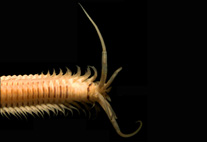Abstract
Onuphis eremita, type species of the genus, and Onuphis pancerii, originally from La Rochelle (France) and Gulf of Naples (Italy) respectively, are two of the earliest described species of the family Onuphidae. Yet, the definition of the former was extremely confused, the latter was considered its synonym for nearly a century, and types do not exist. We have examined a large amount of material, old museum collections and newly collected specimens from the European Atlantic and Mediterranean and conclude that both, O. eremita and O. pancerii, are valid species. The most obvious differences are that O. eremita is a slender species with only tridentate pseudocompound hooks while O. pancerii is much more robust and has pseudocompound hooks with bi- and tridentate (or even multidentate) tips. Neotypes have been designated for both species and the two taxa are redescribed and illustrated. We regard O. eremita sensu stricto, as redefined on the neotype here, to be restricted to the European Atlantic and western and central Mediterranean; other records need to be re-evaluated. Some specimens of both species were collected with eggs (~ 200 µm diameter) protruding through openings in the body wall, and some O. eremita had ect-aquasperm, suggesting that reproduction is by broadcast spawning and indirect development.

